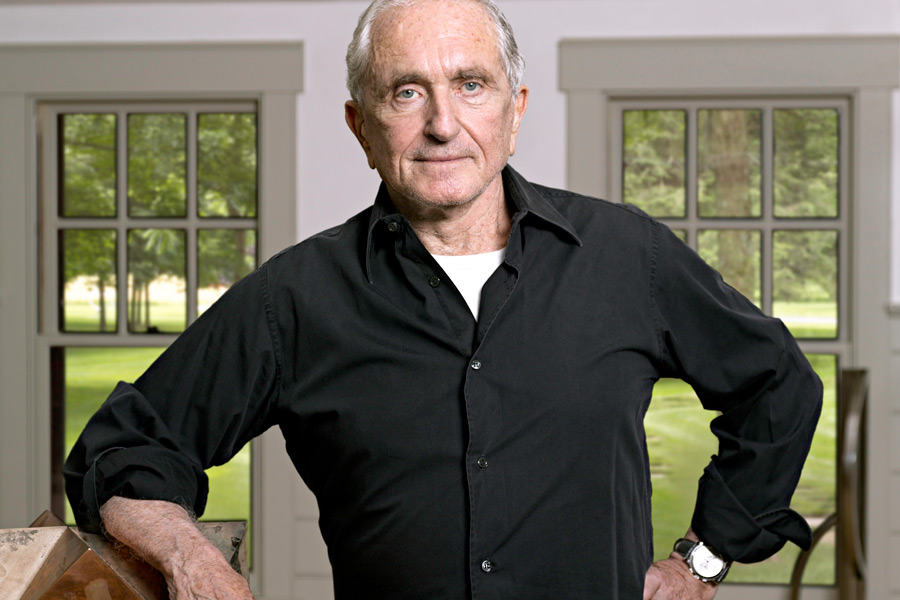Who's Here: Arthur Carter, Publisher, Sculptor, Banker

Arthur Carter is probably best known in New York metropolitan area for having founded the New York Observer and the Litchfield Country Times. He also, for ten years, was half-owner of The East Hampton Star. You might be tempted to think that Carter’s career started and ended with publishing. But you would be wrong about that. Publishing was only part of this man’s career. It weaved its way through many different careers.
After graduating college, Carter was the commanding officer of a 95-foot Coast Guard patrol boat involved in search, air and rescue out in the Atlantic Ocean. He was in the investment banking business for eight years, partnering with Roger Berlind and Sandy Weill. He did a turn at Lehman Brothers. He formed his own company, the Carter Group, which at one point owned or was the significant shareholder in many publicly traded corporations around the country. Then, in recent years, he’s sold all but one these businesses and now spends much of his time making highly regarded large sculptures which are in museums and in public spaces, most notably in Manhattan at NYU. He makes these sculptures in a large barn studio in Connecticut with several hired assistants. He had gallery shows on Madison Avenue, in other cities and during this month, his work fills the main gallery space at the Southampton Arts Center (formerly the Parrish) on Jobs Lane. In anticipation of interviewing him at his Hamptons home, I went to see his work. It is not the work of some successful businessman dabbling. The works, designs in steel, are strong, complex, thoughtful and soaring. It thrilled me to walk through them. It will thrill you if you do too. The show remains up until August 9.
Frankly, I expected to meet a man who was fully absorbed in the complicated parts of his life. Instead, I found an upright handsome man who was low-key, friendly and formal. He is, in essence, still at heart a Coast Guardsman. He was 22 when he took command of that ship. Maybe those in charge saw what I saw. Maybe he was that way before he joined the Coast Guard. He thinks about what to do, he makes a decision and, without any backing and forthing, without high emotions or regrets, he then does it.
Arthur Carter and his wife enjoy the summers on a 15 acre waterfront estate in Remsenberg he bought almost 50 years ago that looks out onto the calm waters of Moriches Bay. There are several buildings on the property. Flowered walkways and tall trees guide you down manicured lawns to them. It is a very private, peaceful place.
Arthur and I settled on sofas in a comfortable living room looking out across the lawn to the water and we started the conversation by talking about the fact that both of us have founded three newspapers in our lives. So we compared notes. His three are still running. Two of my three are: Dan’s Papers and the Block Island Times. The East Village Other, an underground newspaper, thrived in New York City for ten years and then collapsed in a fiery crash.
I then began the interview, asking him about his early life.
Arthur Carter was born in New York City and raised in Woodmere, Long Island, which at that time, the early 1930s, was largely farmland. There were residential streets, however, and he and his parents and a younger sister lived in a small house on one of them. His father was a lifetime IRS Agent – 48 years in that service, at a headquarters in New York. His mother taught French privately. There was a nice residential neighborhood in Woodmere. But they lived in another, on the other side of the tracks.
“We were the only people renting in our block when I first came on the scene. Everybody else, and that included all my friends, were in homes that their parents owned. I thought we should own one too. So, one day, when I was 8, I went out on my bike and asked around and found a house for sale on the next block and told my mom and dad about it. When they bought it, I considered I had found it for them and was pretty proud at having done that.”
“Other side of the tracks?”
“No. It was still on the same side. Just that it would be ours.”
Arthur went to public school. He became a chess player. When he was in first grade, he began studying classical piano. His mother played piano. He continued on with that until he was 14, when he was introduced to Rudolph Serkin, who taught him for four more years. He gave a concert in Lenox, Massachusetts one year. But when he graduated Woodmere High School, he found he would have to make a decision. Next stop would be either a music conservatory or college. He chose college. And he gave up the piano.
Arthur was registered as a pre-med student at first, but then when the time came, he chose French as his major. He was at Brown University, in Providence, Rhode Island. He’d come home for the summer to Woodmere and live with his parents. His mother had become ill. That lasted seven or eight years.
“This was a troubling time for me,” he said.
He worked as a locker boy and lifeguard at Lido Beach and Atlantic Beach during those summers. When he graduated college, he was faced with another decision. The Korean War was under way. He could join the military or go to graduate school. He decided on OCS, which is Officer Training. And so he spent four months at the Coast Guard Academy at New London. And, after graduation, he was assigned, at the age of 22, to be the commanding officer of a ship.
“What was its name?”
“It didn’t have a name. It had a number.”
The ship patrolled the heavy seas of the Atlantic, rescuing people, towing boats in trouble. The Cold War was in full swing.
“We stopped and searched big ships from Iron Curtain ports,” he said. “As Captain, I would interrogate the officers of those ships.”
He left the service at 24 and took a job with the investment banking firm of Lehman Brothers as an assistant. He prepared analyses, wrote reports and organized paperwork for new issues and acquisitions.
“But I had no idea of what I was doing. I had no background in the field. I liked it, but I thought I should learn more about it.”
With the firm’s recommendation, he was accepted to the Amos Tuck School at Dartmouth where got an MBA.
During this time, a friend introduced him to Linda Schweitzer, a girl who had been raised in Hewlett, one of the other “five towns” that included Woodmere. She was four years younger than he was, but they dated and then married. After finishing at Dartmouth, the couple returned to New York and set up housekeeping at a 2-bedroom apartment in East Rockaway, not far from Woodmere. Soon they had a son and two daughters.
“I remember taking my son to the 1964 World’s Fair in Queens,” he told me. “It warmed my heart. My father had taken me to the 1939 World’s Fair in Queens, just next door.”
At that point, he and a friend, Sandy Weill, who also had an apartment in East Rockaway, and also Roger Berlind, a childhood friend from Woodmere, decided to set up their own firm.
Carter, Berlind and Weill set up offices at 37 Wall Street that consisted of one room with four desks, one each for the three partners and a fourth for a secretary-receptionist. The firm did mergers, acquisitions, money management and investment banking. The partners stayed together for nine years.
“At that point,” Carter said, “I decided I wanted to run an investment banking business on my own, but using my own money. I raised $45 million for a public offering. I left Wall Street and opened The Carter Group on the first floor of a large skyscraper at 66th Street and Madison Avenue and I started buying businesses, always publicly traded companies.”
I mentioned to Carter that most people who do this lean toward one sort of business or another in a particular field. He told me that was not what he did.
“I just looked around. I’d be interested in any business with a good balance sheet and a good structure that I thought had a good investment opportunity. There were a whole range of such businesses. For the next ten years, I was buying businesses.”
All of them were under the umbrella of the Carter Group, which owned utilities, manufacturing companies, electronics companies—one had 20 subsidiaries—an industrial spring company. He also built and developed a shopping center, on land he owned, which became the very successful Sunrise Mall.
“How much were you bringing in at the peak of your business?” I asked. This is generally a provocative question. But this was a long time ago.
“Eventually I was doing $300,000,000 in revenues a year,” he said. “But then I decided to wind it down. It took ten years to build the business, and 20 years, from 1981 to 2001 to wind it down, but I sold everything except for one business.”
“What was that?”
“The Industrial Spring Company. It is a steady, solid company with very few ups and downs. My idea was that I would sell almost everything and just live well from the money I got from selling those things.”
1981 was the year he had started the Litchfield County Times. I asked him about that.
“I just thought the region would support a good weekly newspaper. My input involved design and graphics. I wanted the paper to be a broadsheet, with a very large photograph on the front page every week. Indeed, that led me to sketching and then sculpture. I became interested in design.”
By this time, Carter was married to his second wife Dixie Carter and was living in the San Remo on Central Park West. He had two more daughters. He also drove weekends to a farm he had bought, 1,500 acres, in Roxbury and Washington, Connecticut. It was there he converted one of his barns to a sculpture studio. He still works there.
“What brought you out to the Hamptons?” I asked.
“After my divorce, my children moved here. So I bought this house to be near them.”
I asked him about his purchase of 50% of The East Hampton Star. This was around 1992.
“A friend told me they were looking for someone to make an investment. I came in for half. Over the years I’d say this or that, but I just let the Rattrays run it. My main interest, again, was just with the graphics.”
“You sold your interest after ten years?”
“Mrs. Rattray came and offered a good price for my half, so I decided to sell it.”
Carter founded the weekly New York Observer in 1987. “I thought the other papers in the city were pretty dull and drab. I thought that a new weekly, which I called the Observer, could be a little spark on the newsstand. I hired a really smart and talented editor, Peter Kaplan. We used peach-colored paper. And I became fully engaged with its design, which always had that large image on the front page.”
Carter was now in the city living in Manhattan at 2 East 67th Street. The pundits thought, especially when he bought half the East Hampton Star, that he was entering the media business. But he was not. He did these things because they were good business transactions. He also, in an act of philanthropy, provided NYU with some money to build a Journalism School on their campus just south of Washington Square Park. It’s called the Arthur L. Carter School of Journalism.
Arthur Carter is about being a successful businessman, a good designer and a good provider. For 40 years now he’s been married to a prominent psychologist, Linda Carter, who is a professor at NYU’s School of Medicine. And when the time came, in 2005, he sold the Observer to the Kushner family. He has not looked back.
And now, in his third, or perhaps fourth career, he is a sculptor, enjoying himself with his art. And he seems quite at peace with himself and the world.



